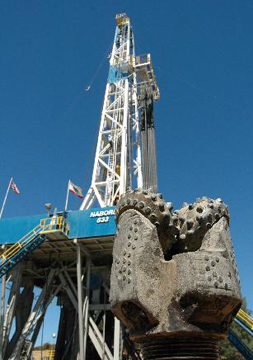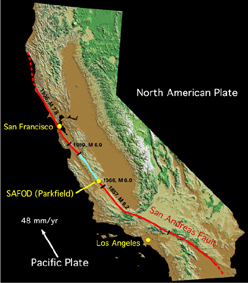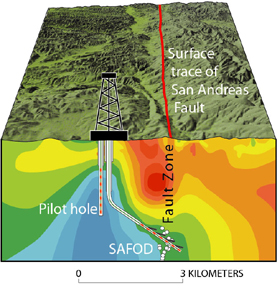Geotimes

Untitled Document

Web Extra
Friday, August 12, 2005
Drilling project finds fault
Towering 56 meters above the ground, a drill rig in Parkfield, Calif., sends
a bit through miles of earth below. In contrast to what the rig was designed
for, however, personnel running the operation did not expect to hit oil. Rather,
they expected to hit the source of some of California's numerous earthquakes:
the San Andreas Fault.
 The drilling
is part of the San Andreas Fault Observatory at Depth (SAFOD)
project, the first of its kind to look directly at an active fault to learn
about the mechanics of earthquake generation. And SAFOD reached a significant
milestone last week when, after two summers of near-constant drilling, they
hit the fault. Now, researchers are working to implement monitoring systems
within the permanent underground observatory that they hope will provide critical
information for future earthquake studies.
The drilling
is part of the San Andreas Fault Observatory at Depth (SAFOD)
project, the first of its kind to look directly at an active fault to learn
about the mechanics of earthquake generation. And SAFOD reached a significant
milestone last week when, after two summers of near-constant drilling, they
hit the fault. Now, researchers are working to implement monitoring systems
within the permanent underground observatory that they hope will provide critical
information for future earthquake studies.
On Aug. 2, scientists
drilled down about 3 kilometers and reached the San Andreas Fault. The drilling
bit in the foreground was the 12th of 14 used this summer in the SAFOD project
to drill through the fault and establish a permanent earthquake observatory.
All images are courtesy of EarthScope.
In the past, seismologists conducted earthquake research only at the surface,
says Mark Zoback, a geophysics professor at Stanford University,
and co-principal investigator of SAFOD along with Stephen Hickman and William
Ellsworth of the U.S. Geological Survey (USGS). Yet to be
tested were fundamental theories of earthquake mechanics such as the width and
composition of active fault zones at depth, and what pressures, stresses and
chemical processes are responsible for fault activity. Collecting this information
via SAFOD could aid scientists in determining whether earthquakes are predictable.
"The problem is, in the absence of hard data about the fault at depth,
you can almost say that every idea is a good idea, even when they're not,"
Zoback says.
In hopes of gathering the missing data from the fault itself, the SAFOD project
commenced drilling operations in June 2004. "It's a great voyage of discovery,
almost like a Jules Verne novel," says Charna Meth of EarthScope.
SAFOD is one component of the National Science Foundation's EarthScope program,
being carried out in collaboration with USGS, to study the North American Plate
(see Geotimes, April 2002).
 But not just
any location along the 1,287-kilometer-long (800-mile) San Andreas Fault —
which runs through California and marks the boundary between the Pacific and
North American plates — could have provided optimal drilling and experimental
conditions. SAFOD scientists agreed upon a unique segment in Parkfield, Calif.,
about halfway between Los Angeles and San Francisco. This 25-kilometer-long
segment gained fame for seemingly regular earthquakes, with at least six magnitude-6.0
events since 1857, including one last September. As a result, Parkfield is the
most extensively instrumented fault section in the world and has been the site
of several earthquake prediction experiments (see Geotimes,
March 2005).
But not just
any location along the 1,287-kilometer-long (800-mile) San Andreas Fault —
which runs through California and marks the boundary between the Pacific and
North American plates — could have provided optimal drilling and experimental
conditions. SAFOD scientists agreed upon a unique segment in Parkfield, Calif.,
about halfway between Los Angeles and San Francisco. This 25-kilometer-long
segment gained fame for seemingly regular earthquakes, with at least six magnitude-6.0
events since 1857, including one last September. As a result, Parkfield is the
most extensively instrumented fault section in the world and has been the site
of several earthquake prediction experiments (see Geotimes,
March 2005).
This map depicts the "locked"
portion of the San Andeas Fault (red) and the "creeping" segment (blue).
SAFOD scientists drilled at Parkfield, Calif., where these two fault types meet.
The fault segment's smaller and more frequent earthquakes, however, led SAFOD
project scientists to drill at Parkfield. The site borders a section of the
fault that constantly "creeps" at a rate of about 2 centimeters per
year due to small and constant stresses, and a section that remains locked.
The transition region produces patches of repeating "microearthquakes,"
as opposed to the larger and less frequent earthquakes of the locked regions.
SAFOD researchers used the frequent microearthquakes as a "guide star"
to find the location of the fault before drilling, Zoback says. And regular
tremors will also produce more raw data for experiments.
The drilling crew expected to reach the fault zone sooner than Aug. 2. "Where
is it?" Zoback says researchers asked. But when drilling rates suddenly
quickened and carbon dioxide and other gas levels increased — probably
because the broken-up nature of the fault allows the gas to more readily escape
— they knew that they had reached the San Andreas Fault, Zoback says.
 After two summers,
14 drill bits, and two potential project-ending drill jams, the final borehole
traced vertically downward for 2.5 kilometers in the Pacific Plate, and then
shifted to a 55 degree angle for the remaining 0.7 vertical miles across the
tens of meters of fault, and stopped at the hard rocks of the North American
Plate. "We were pleased, we were relieved to have finally done it,"
Zoback says, "and yet there wasn't the exaltation that you might have thought,
simply because this is the first of many challenges."
After two summers,
14 drill bits, and two potential project-ending drill jams, the final borehole
traced vertically downward for 2.5 kilometers in the Pacific Plate, and then
shifted to a 55 degree angle for the remaining 0.7 vertical miles across the
tens of meters of fault, and stopped at the hard rocks of the North American
Plate. "We were pleased, we were relieved to have finally done it,"
Zoback says, "and yet there wasn't the exaltation that you might have thought,
simply because this is the first of many challenges."
Scientists drilled a pilot hole in summer
2002 and placed instruments inside (red dots) that helped determine the approximate
locations of microearthquakes (white dots). This information helped scientists
decide where to drill the borehole that crosses the fault. The horizontal black
lines represent the four cores to be removed in summer 2007.
The crew must now make geophysical measurements and obtain small "side-wall"
cores before they line the borehole with steel and cement for long-term stability.
Then, instrumentation will be lowered into the hole as part of the process of
building a geophysical observatory directly within the active fault trace. At
the same time, preparations will be made for drilling that will resume in summer
2007, when the scientists plan to reenter the main borehole and remove four
250-meter cores from its side. Finally they will deploy an array of instruments
including seismometers and deformation sensors. "By coring into both kinds
of faults in 2007, we will be able to actually address questions of how the
composition of rock in the fault will affect its behavior," Zoback says.
When completed, the observatory will collect data for at least 20 years.
"Once we put in the instrumentation, we're going to have an observatory
where we can watch earthquakes work and we're going to answer questions such
as whether earthquakes are predictable," Zoback says. "What we've
done will enable new kinds of science to be done for decades. That's what we
feel so good about."
Kathryn Hansen
Links:
San
Andreas Fault Observatory at Depth
EarthScope
USGS
Earthquake Hazards Program and the Parkfield Experiment
Stanford
Department of Geophysics
Past Geotimes related
coverage:
"Earthquakes:
Predicting the Unpredictable?" Geotimes, March 2005
"Parkfield finally quakes,"
Geotimes, Sept. 28, 2004
"Magnifying a Continent," Geotimes,
March 2004
"EarthScope closer to a reality,"
Geotimes, Oct. 11, 2002
"A new
chance for Parkfield," Geotimes, September 2002
"EarthScope:
Reassembling a Continent in Motion," Geotimes, April 2002
Back to top
Untitled Document

 The drilling
is part of the San Andreas Fault Observatory at Depth (SAFOD)
project, the first of its kind to look directly at an active fault to learn
about the mechanics of earthquake generation. And SAFOD reached a significant
milestone last week when, after two summers of near-constant drilling, they
hit the fault. Now, researchers are working to implement monitoring systems
within the permanent underground observatory that they hope will provide critical
information for future earthquake studies.
The drilling
is part of the San Andreas Fault Observatory at Depth (SAFOD)
project, the first of its kind to look directly at an active fault to learn
about the mechanics of earthquake generation. And SAFOD reached a significant
milestone last week when, after two summers of near-constant drilling, they
hit the fault. Now, researchers are working to implement monitoring systems
within the permanent underground observatory that they hope will provide critical
information for future earthquake studies. 
 But not just
any location along the 1,287-kilometer-long (800-mile) San Andreas Fault —
which runs through California and marks the boundary between the Pacific and
North American plates — could have provided optimal drilling and experimental
conditions. SAFOD scientists agreed upon a unique segment in Parkfield, Calif.,
about halfway between Los Angeles and San Francisco. This 25-kilometer-long
segment gained fame for seemingly regular earthquakes, with at least six magnitude-6.0
events since 1857, including one last September. As a result, Parkfield is the
most extensively instrumented fault section in the world and has been the site
of several earthquake prediction experiments
But not just
any location along the 1,287-kilometer-long (800-mile) San Andreas Fault —
which runs through California and marks the boundary between the Pacific and
North American plates — could have provided optimal drilling and experimental
conditions. SAFOD scientists agreed upon a unique segment in Parkfield, Calif.,
about halfway between Los Angeles and San Francisco. This 25-kilometer-long
segment gained fame for seemingly regular earthquakes, with at least six magnitude-6.0
events since 1857, including one last September. As a result, Parkfield is the
most extensively instrumented fault section in the world and has been the site
of several earthquake prediction experiments  After two summers,
14 drill bits, and two potential project-ending drill jams, the final borehole
traced vertically downward for 2.5 kilometers in the Pacific Plate, and then
shifted to a 55 degree angle for the remaining 0.7 vertical miles across the
tens of meters of fault, and stopped at the hard rocks of the North American
Plate. "We were pleased, we were relieved to have finally done it,"
Zoback says, "and yet there wasn't the exaltation that you might have thought,
simply because this is the first of many challenges."
After two summers,
14 drill bits, and two potential project-ending drill jams, the final borehole
traced vertically downward for 2.5 kilometers in the Pacific Plate, and then
shifted to a 55 degree angle for the remaining 0.7 vertical miles across the
tens of meters of fault, and stopped at the hard rocks of the North American
Plate. "We were pleased, we were relieved to have finally done it,"
Zoback says, "and yet there wasn't the exaltation that you might have thought,
simply because this is the first of many challenges."